ISSN ONLINE(2320-9801) PRINT (2320-9798)
ISSN ONLINE(2320-9801) PRINT (2320-9798)
C.Saranya1, G.Radha1, R.Subash2
|
| Related article at Pubmed, Scholar Google |
Visit for more related articles at International Journal of Innovative Research in Computer and Communication Engineering
In cloud computing, data owners may share their outsourced data with a number of users, who might want to only retrieve the data files they are interested in. One of the most popular ways to do so is through keywordbased retrieval. We propose a new searchable encryption scheme, in which novel technologies in cryptography community, including ECC encryption and the vector space model. In the proposed scheme, the data owner encrypts the searchable index with kNN. When the cloud server receives a query consisting of multikeywords, it computes the scores from the encrypted index stored on cloud and then returns the encrypted scores of files to the data user. Next, the data user decrypts the scores and picks out the top-k highest- scoring files’ identifers to request to the cloud server. The retrieval takes a two-round communication between the cloud server and the data user. The scheme, the privacypreserving multi-keyword ranked search over encrypted data in cloud computing scheme, in which ranking is done at the user side while scoring calculation is done at the server side.Thorough analysis investigating privacy and efficiency guarantees ofproposed schemes is given. Experiments on the real-world data set further show proposed schemes indeed introduce lowoverhead on computation and communication.
KEYWORDS |
| Cloud computing, searchable encryption, privacy-preserving, keyword search, ranked search, Two- Round Searchable Encryption Scheme |
I. INTRODUCTION |
| Cloud computing [1], a critical pattern for advanced data service, has became a necessaryfeasibility for data users to outsource data. Controversies on privacy, however, have beenincessantly presented as outsourcing of sensitive information including emails, health historyand personal photos is explosively expanding. Reports of data loss and privacy breaches incloud computing systems appear from time to time [2][3].The main threat on data privacy roots in the cloud itself [4]. When users outsource theirprivate data onto the cloud, the cloud service providers are able to control and monitor the dataand the communication between users and the cloud at will, lawfully or unlawfully,. Instancessuch as the secret NSA program, working with AT&T and Verizon, which recorded over 10million phone calls between American citizens, cause uncertainty among privacy advocates,and the greater powers it gives to telecommunication companies to monitor user activity [5].To ensure privacy, users usually encrypt the data before outsourcing it onto cloud, which bringsgreat challenges to effective data utilization. However, even if the encrypted data utilizationis possible, users still need to communicate with the cloud and allow the cloud operates on theencrypted data, which potentially causes leakage of sensitive information.Furthermore, in cloud computing, data owners may share their outsourced data with anumber of users, who might want to only retrieve the data files they are interested in. One ofthe most popular ways to do so is through keyword-based retrieval. Keyword-based retrieval isa typical data service and widely applied in plaintext scenarios, in which users retrieve relevantfiles in a file set based on keywords. However, it turns out to be a difficult task in ciphertextscenario due to limited operations on encrypted data. Besides, in order to improve feasibilityand save on the expense in the cloud paradigm, it is preferred to get the retrieval result withthe most relevant files that match users’ interest instead of all the files, which indicates thatthe files should be ranked in the order of relevance by users’ interest and only the files with thehighest relevances are sent back to users.A series of searchable symmetric encryption schemes have been proposed to enable search onciphertext. Traditional SSE schemes [6, 7] enable users to securely retrieve the ciphertext, butthese schemes support only boolean keyword search, i.e., whether a keyword exists in a file ornot, without considering the difference of relevance with the queried keyword of these files in theresult. To improve security without sacrificing efficiency, schemes presented in [8] showthat they support top-k single keyword retrieval under various scenarios. Authors [9, 10]made attempts to solve the problem of top-k multi-keyword over encrypted cloud data. Theseschemes, however, suffer from two problems-boolean representations and how to strike a balancebetween security and efficiency. In the former, files are ranked only by the number of retrievedkeywords, which impairs search accuracy. In the latter, security is implicitly compromised totradeoff for efficiency, which is particularly undesirable in security-oriented applications.Preventing the cloud from involving in ranking and entrusting all the work to the user is anatural way to avoid information leakage. However, the limited computational power on theuser side and the high computational overhead precludes information security. The issue ofsecure multi-keyword top-k retrieval over encrypted cloud data thus is: how to make the clouddo more work during the process of retrieval without information leakage.In this paper, we introduce the concepts of similarity relevance and scheme robustness toformulate the privacy issue in searchable encryption schemes, and then solve the insecurityproblem by proposing a two-round searchable encryption (TRSE) scheme. Novel technologiesin the cryptography community and information retrieval community are employed, includinghomomorphic encryption and vector space model. In the proposed scheme, the majority ofcomputing work is done on the cloud while the user takes part in ranking, which guarantees topkmulti-keyword retrieval over encrypted cloud data with high security and practical efficiency.Our contributions can be summarized as follows:1) propose the concepts of similarity relevance and scheme robustness. We thus performthe first attempt to formulate the privacy issue in searchable encryption, and we show server sideranking based on order-preserving encryption (OPE) inevitably violates data privacy.2) propose a two-round searchable encryption (TRSE) scheme, which fulfills the securemulti-keyword top-k retrieval over encrypted cloud data. Specifically, for the first time weemploy relevance score to support multi-keyword top-k retrieval.3) Thorough analysis on security demonstrates the proposed scheme guarantees high dataprivacy. Furthermore, performance analysis and experimental results show that our scheme isefficient for practical utilization.The rest of this paper is organized as follows. We provide scenario and related backgroundin Section 2. In Section 3, we present the detailed description of the proposed searchableencryption scheme. In Section 4 we discuss proposed scheme and the security analysis and performance analysis are given in Section 5. Section 6 concludes this paper. |
II. RELATED WORK |
| Ning Caoy et al. [11] has proposed method which allow users to securely search complete encrypted data through keywords, these method support only Boolean search, without capturing any relevant data. This approach suffers from two main drawbacks when directly applied in the context of Cloud Computing. First one, users, who do not necessarily have preknowledge of the encrypted cloud data, have to post process every got file in order to find ones most matching their interest;another drawback, invariably getting all files containing the queried keyword further incurs unnecessary network traffic, when retrieve more than one files.However, it only supports single keyword search. Where anyone with public key can write to the data stored on server but only authorized users with private key can search. Public key solutions are usually very computationally expensive however.Cong Wang et al [12] discuss the major disadvantage of above mentioned techniques gets the better of in ranked keyword search. This system enables data users to find the most related information rapidly, rather than burdensome sorting through every match in the content collection. Ranked search can also elegantly eliminate unnecessary network traffic by sending back only the most relevant data. For privacy protection, such ranking function, however, should not leak any keyword relevant information. Another One, to improve search result accuracy as well as enhance user searching experience, it is also essential for such ranking system to support multiple keywords search.Deepa P et al [13] has discussed this technique; conjunction of keywords is implemented for searching. The conjunctive keyword search mechanism will retrieve most efficient and relevance of data files. The conjunctive keyword search automatically creates ranked results so that the searching is efficient and flexible. This technique uses the wildcard based method and gram based method for constructing fuzzy keyword sets and symbol based trie- traverse scheme for generating a multi way tree to store the fuzzy keyword sets generated. This reduces the storage overhead. The Edit distance concept used for quantifies the keyword similarity. Kiruthigapriya Sengoden et al. [14], have proposed concept based searching techniques return a list of files that not only contain the exact search terms, but also search words are conceptually related to the topic, which provides a wider search scope capability. So the combination of both keyword searches along with concept search produce the relevant search result which greatly improve the efficiency of search. Jin Li et al[15] have proposed this method, It enhances system usability when searching input exactly matches. Keywords are measured using edit distance and fuzzy keyword sets are making. Straight forward and wild card based are the two approaches are dealt with edit distance .In straight forward approach edit distance are calculated where all the forms of keywords are to be listed .Based on this indexing is built .Trapdoor are shared between user and the owner While retrieving file user computes the trapdoor based on the request, server matches with index table and return all potential identifiers. Reza Curtmola et al [16] presented a Searchable symmetric encryption (SSE) allows a party to outsource the storage of its data to another party (a server). SSE schemes enable users to securely retrieve the cipher text, but these method support only Boolean keyword search, i.e., whether a keyword subsists in a file or not, without regarding the difference of relevance with the queried keyword of these files in the result. To improve security without sacrificing efficiency, schemes presented in [17], [18] show that they support top-k single keyword retrieval under various scenarios in a secret manner, while maintaining the ability to selectively search complete it. So there is a need of new work to overcome these drawbacks. |
III. PROPOSED METHODOLOGY |
| The proposed system is for searching the data from the encrypted data.The data gets encrypted by data owner with the keyword and stored in cloud.The user search for the data, the system will search for the results from the encrypted data.The relevance scoring and ranking methods are used for providing the accurate top k results. Data encryption protects data security to some extent,but at the cost of compromised efficiency. Searchable encryption scheme allows retrieval of encrypted data over cloud. In this project, we focus on addressing data privacy issues using Searchable encryption scheme. For the first time, we formulate the privacy issue from the aspect of similarity relevance and scheme robustness. To eliminate the leakage, we propose a two-round searchable encryption (TRSE) scheme that supports top-k multi keyword retrieval. In TRSE, we employ a vector space model and homomorphic encryption. The vector space model helps to provide sufficient search accuracy, and the homomorphic encryption enables users to involve in the ranking while the majority of computing work is done on the server side by operations only on ciphertext. As a result, information leakage can be eliminated and data security is ensured. The architecture diagram is given in Fig.1. |
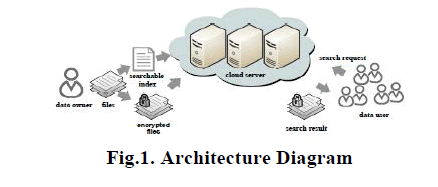 |
| In this work, a two-round searchable encryption (TRSE) scheme proposed that supports top-k multi-keyword retrieval. In TRSE, we employ a vector space model and homomorphic encryption. The vector space model helps to provide sufficient search accuracy, and the homomorphic encryption enables users to involve in the ranking while the majority of computing work is done on the server side by operations only on ciphertext. As a result, information leakage can be eliminated and data security is ensured. Thorough security and performance analysis show that the proposed scheme guarantees high security and practical efficiency. The proposed scheme is illustrated if Fig.2. |
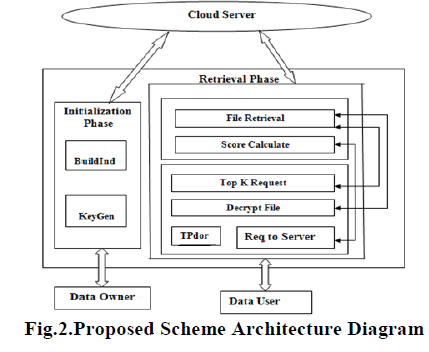 |
1.1. Data owner |
| A cloud computing system hosting data service, as illustrated in Figure 1 in which three different entities are involved: Cloud server, Data owner and Data user. The cloud server hosts thirdparty data storage and retrieve services. Since data may contain sensitive information, the cloud servers cannot be fully entrusted in protecting data. For this reason, outsourced files must be encrypted. Any kind of information leakage that would affect data privacy is regarded as unacceptable. |
1.2. Encryption |
| To alleviate the computational burden on user side, computing work should be at the server side, need an encryption scheme to guarantee the operability and security at the same time on server side. Homomorphic encryption allows specific types of computations to be carried out on the corresponding ciphertext. The result is the ciphertext of the result of the same operations performed on the plaintext. That is, homomorphic encryption allows computation of ciphertext without knowing anything about the plaintext to get the correct encrypted result. |
1.3. Searchable indexing |
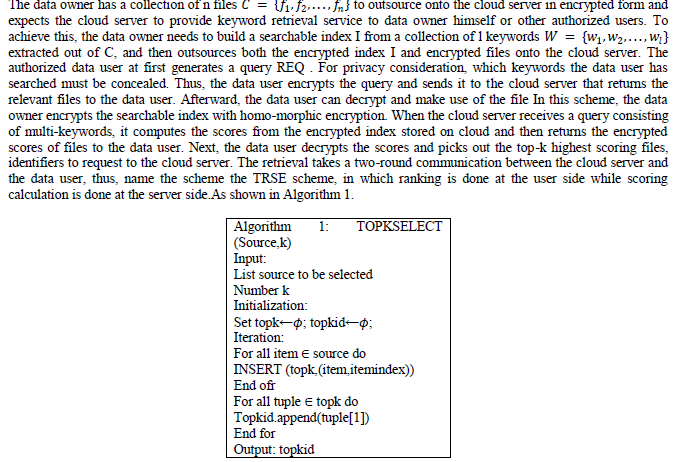 |
1.4. Multi-keyword Search |
| This module is used to help the user to get the accurate result based on the multiple keyword concepts. The users can enter the multiple words query, the server is going to split that query into a single word after search that word file in our database. Finally, display the matched word list from the database and the user gets the file from that list. The data user is authorized to process multi-keyword retrieval over the outsourced data. Thus the data user encrypts the query and sends it to the cloud server that returns the relevant files to the data user. Afterwards, the data user can decrypt and make use of the files. |
1.5. Relevance Scoring |
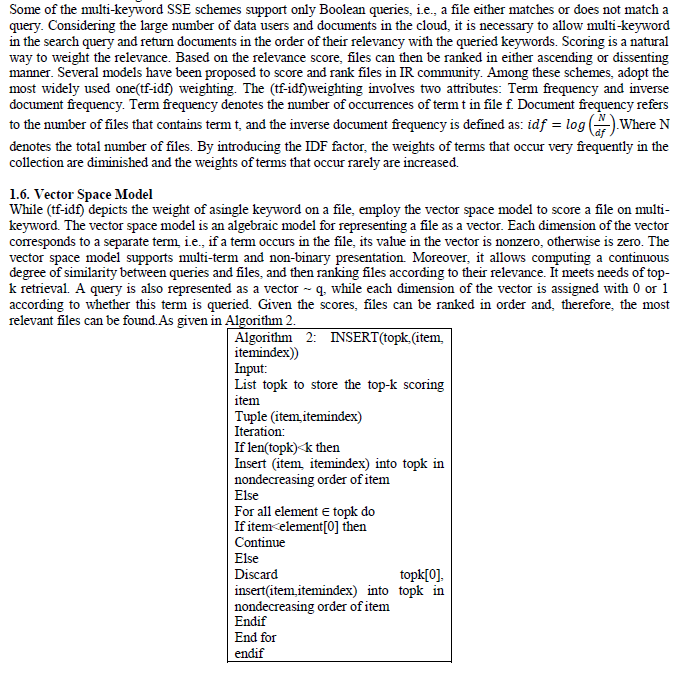 |
1.7. TRSE Design |
| Existing SSE schemes employ server-side ranking based on OPE to improve the efficiency of retrieval over encrypted cloud data. However, server-side ranking based on OPE violates the privacy of sensitive information, which is considered uncompromisable in the security oriented third party cloud computing scenario, i.e., security cannot be tradeoff for efficiency. To achieve data privacy, ranking has to be left to the user side. Traditional user-side schemes, however, load heavy computational burden and high communication overhead on the user side, due to the interaction between the server and the user including searchable index return and ranking score calculation. Thus, the user-side ranking schemes are challenged by practical use. A more serversiding scheme might be a better solution to privacy issues. We propose a new searchable encryption scheme, in which novel technologies in cryptography community and IR community are employed, including homoorphic encryption and the vector space model. In the proposed scheme, the data owner encrypts the searchable index with homomorphic encryption. When the cloud serverreceives a query consisting of multi keywords, it computes the scores from the encrypted index stored on cloud and then returns the encrypted scores of files to the data user. Next, the data user decrypts the scores and picks out the top-k highest scoring files’ identifiers to request to the cloud server. The retrieval takes a two-round communication between the cloud server and the data user. We, thus, name the scheme the TRSE scheme, in which ranking is done at the user side while scoring calculation is done at the server side. |
1.8. Framework of TRSE |
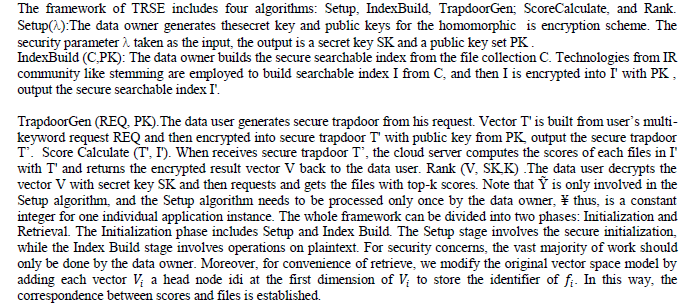 |
1.9. Log file generation |
| A log file will be generated at the server for each action done by any user (both owner and data user) for any file. This information can be used by the cloud admin to know about the issues happened while uploading, encrypting or downloading the files. This information can also be used by data owner to know the statistics about his files downloads.The Retrieval phase involves TrapdoorGen, Score Calculate, and Rank, in which the data user and the cloud server are involved. As a result of the limited computing power on the user side, the computing work should be left to server side as much as possible. Meanwhile, the confidentiality privacy of sensitive information cannot be violated. |
IV. EXPERIMENTAL RESULTS AND DISCUSSION |
| In this section, a thorough experimentalevaluation of the proposed technique demonstratedon a real-world dataset: the Enron Email Data Set [35]. We randomly selectdifferent number of e-mails to build data set. The wholeexperiment system is implemented by C language on aLinux Server with Intel Xeon Processor 2.93 GHz. Thepublic utility routines by Numerical Recipes are employedto compute the inverse of matrix. The performance of ourtechnique is evaluated regarding the efficiency of existingMRSE schemes, as well as the tradeoff betweensearch precision, privacy and computation time cost for k-word retrieval. |
1.10. Precision Result Comparison |
| Fig. 3 shows that the precision comparison results between proposed TRSE, MRSE and SSE. From the results, it is well know thatproposed schemeobtain high precision indicating the good purity ofretrieved documents.However, user’s rank privacy may have been partiallyleaked to the cloud server in MRSE and SSE methods |
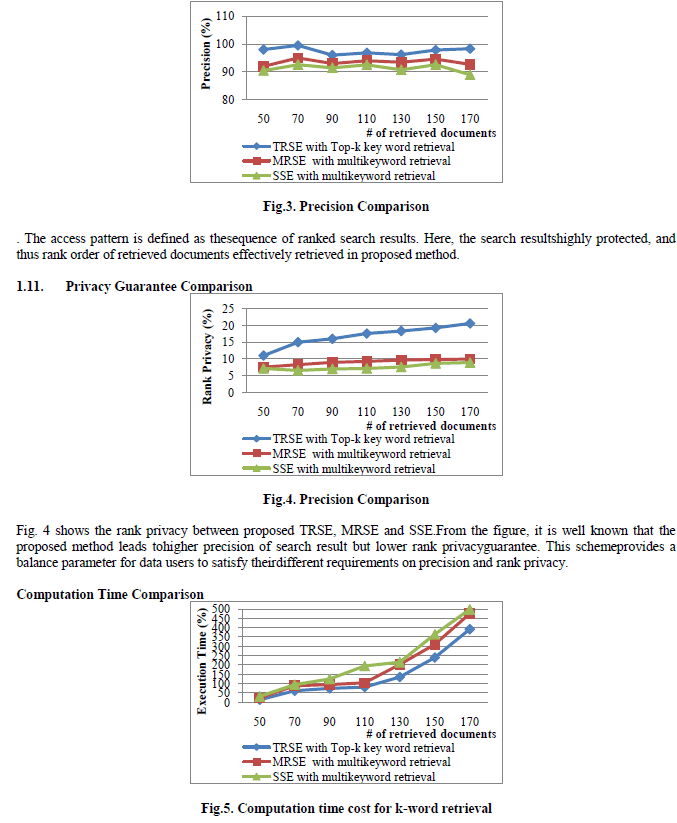 |
V. CONCLUSION AND FUTURE WORK |
| In this paper, we motivate and solve the problem of secure multi-keyword top-k retrieval over encrypted cloud data. We define similarity relevance and scheme robustness .Based on OPE invisibly leaking sensitive information, we devise aserver-side ranking SSE scheme. We then propose a TRSE scheme employing the fully homomorphic encryption, which fulfills the security requirements of multi-keyword top-k retrieval over the encrypted cloud data. By security analysis, we show that the proposed scheme guarantees data privacy. According to the efficiency evaluation of the proposed scheme over a real data set, extensive experimental results demonstrate that our scheme ensures practical efficiency. The system is designed to solve the problem of supporting efficient ranked keyword search for achieving effective utilization of remotely stored encrypted data in Cloud Computing. |
References |
|